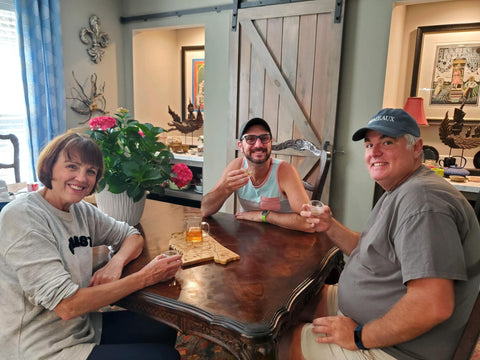We sat down with Scottish Tea Consultant, Beverly Wainwright and asked her to share with us what it takes to develop a quality Oolong tea. It's easy to think it is just dried leaf and water for tea, but there is a lot more to a good cup of tea than that. Owners of the Great Mississippi Tea farm, Jason and Timmy, often talk about the science behind tea and that is apparent as Beverly walks us through the making of our new 13 Moons Oolong tea.
This Oolong tea was made by Beverly as a guest tea maker in the Great Mississippi Tea Shack using our Mississippi grown tea leaves.
So we ask Beverly, what does it take to develop a great cup of Oolong tea?
She gives me a bit of a smile as if to say, 'that's a big question". But she supports my desire to learn and begins to share her vast tea making knowledge.
"Start with a plan".
She starts off by telling us that the first step starts with reading papers on Oolong. Many, many papers. She drafts up a solid plan of the steps required which will get modified with collaboration with Jason & Timmy.
Oolong requires special equipment which Jason and Timmy have invested in. They have been making Oolong teas for some time. The science of Oolong is not new to them. In fact, they are likely some of only a few in the US making this tea which is normally only made overseas, where the leaves are dried in the sun. Here in Mississippi they have used science to master drying the leaves with UV lights. Sun drying is not an approved processing method in the US for tea.
"Careful plucking is a must."
Starting with the leaf, Beverly tells us that you need to start with a great leaf for a quality cup of Oolong tea. The first four leaves are carefully plucked. For their Limited Edition 13 Moons it is 100% hand-plucked for this tea.

They will take their hip tied bags and carry them off into the tea fields to pick for a few hours. Then they head to the Tea Shack to weigh their leaves.

This is where Timmy and Jason's systems are outstanding. They know the exact weight of the leaf they need. How much leaf needs to go on each tray for even drying and then they track all their information to ensure food safety and quality control practices are met. The first picking of tea leaves results in a shortage of enough leaves. So they have to head back out into the field to pick more leaves.
Once they have enough leaves they can begin the withering process.
"You have to shift the leaves every hour to ensure they get even access to the light".
All the leaves are set on multiple racks where they will sit under UV lights for 6 hours. They will then turn the leaves to ensure an even wither.

Beverly shares "it is all about how it might smell, like green bananas or it might smell floral". She will often be found picking up a handful of leaves and giving it a whiff. She has a nose for good tea.
"Oolong's are treated different than Black tea. It involves a gentle oxidation."
Then the tea is placed into the Tumbler to start the oxidation process. With Oolong you want to bruise edges and veins only. You only want partial oxidation or a more gentle oxidation.
So in comparison to other teas, it is a different pluck and different level of oxidation.
Then it is placed into the carding machine. This stops the oxidation and adds flavor. They do this for 5 minutes.

Then they roll the leaves in cloth bundles and then take them out again to be placed back into the carding machine. Roast it again, wither it some more and roll it.

They will be up at 3am in the processing center, making this tea. Once they start, they cannot stop the process. Each step has to be met to ensure the quality of the tea.
Beverly sits before us with a list of steps she has outlined to take. She plans ahead what she will be doing at each point in the process. After a full day of processing, it all starts again the next morning.
For the development of 13 Moons it took 9 experiments to get the roasting right.

"You are trying to work with the chemistry of the leaf. And that is how science and tea are so connected."
Tea is not simply a dried leaf in a cup. A great cup of tea is made by masters of science and tea. The science of growing great leaves and the science of processing them. The team at The Great Mississippi Tea Company have spent years mastering the science. Beverly as well. Together they have created their masterpiece with 13 Moons. This tea will be available in our store very shortly.
See it in our store here.
Want to learn more about growing and processing tea? Check out these great blog topics.



Leave a comment